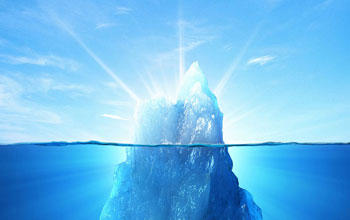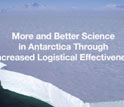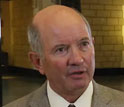News Release 12-141
Blue Ribbon Panel Unveils Findings on Logistical Improvements to Support Antarctic Science
Report details blueprint for securing global research in Antarctica

Blue Ribbon Panel produces findings to improve logistics surrounding Antarctic science.
July 23, 2012
View the July 23, 2012, webcast of the U.S. Antarctic Program Blue Ribbon Panel and video soundbites with Norm Augustine, Don Hartill, and Bart Gordon and Duncan McNabb.
This material is available primarily for archival purposes. Telephone numbers or other contact information may be out of date; please see current contact information at media contacts.
Today, the 12-member U.S. Antarctic Program Blue Ribbon Panel, commissioned by the White House Office of Science and Technology Policy (OSTP) and the National Science Foundation (NSF) released their report, More and Better Science in Antarctica through Increased Logistical Effectiveness. The report is a comprehensive document based on several months of research, containing numerous specific recommendations for the U.S. logistics system for improved support of scientific research in Antarctica and the Southern Ocean.
"The Antarctica Blue Ribbon Panel encourages us to take a hard look at how we support Antarctic science and to make the structural changes, however difficult in the current fiscal environment, that will allow us to do more science in the future," said NSF Director Subra Suresh. "I am grateful to the panel for committing to such a vital review, and I look forward to reviewing their recommendations for securing and improving U.S.-led research in Antarctica."
The report is the result of the second phase of a two-part independent review of the U.S. Antarctic Program, which is managed by NSF. A 2011 report issued by the National Research Council asserted that in the next few decades, enhancing science in the Antarctic region will require substantial organizational changes, broader geographical spread, increased international involvement, and a growth in the quantity, duration and networking of observations.
NSF manages and oversees funding to support the entire U.S. Antarctic Program. NSF directly supports research in astrophysics and geospace, organisms and ecosystems, earth science, glaciology, ocean and atmospheric sciences, and integrated system science. It also provides infrastructure and logistical support for all other U.S. federal agencies and other organizations conducting research on the continent, as well as partners internationally to leverage U.S. Antarctic research, infrastructure and logistics investments. NSF maintains three year-round stations on the continent, two icebreaking-research vessels and more than 50 distributed field sites, along with the transportation platforms needed to support them, including channel-clearing icebreakers, fixed and rotary wing aircraft, and traverse and other vehicles.
The Executive Summary of this Blue Ribbon Panel notes that logistical and financial barriers must be overcome and human resource investment adjusted to continue the success of the U.S. Antarctic Program. International engagement is also paramount in continuing this important globally relevant research. Streamlined logistics processes with a dedicated funding stream to support capital improvements will ensure that more dollars will be put to use in field research to the world's benefit.
The Executive Summary and full report are posted on the NSF website.
-NSF-
-
View Video
Report of the U.S. Antarctic Program Blue Ribbon Panel.
Credit and Larger Version -
View Video
Norm Augustine discusses lessons learned from the Antarctic logistics review.
Credit and Larger Version -
View Video
Don Hartill discusses communications connectivity and bandwidth availability in Antarctica.
Credit and Larger Version -
View Video
Panel members Bart Gordon and Duncan McNabb elaborate on importance of U.S. Antarctic science.
Credit and Larger Version
Media Contacts
Deborah Wing, NSF, (703) 292-5344, email: dwing@nsf.gov
The U.S. National Science Foundation propels the nation forward by advancing fundamental research in all fields of science and engineering. NSF supports research and people by providing facilities, instruments and funding to support their ingenuity and sustain the U.S. as a global leader in research and innovation. With a fiscal year 2023 budget of $9.5 billion, NSF funds reach all 50 states through grants to nearly 2,000 colleges, universities and institutions. Each year, NSF receives more than 40,000 competitive proposals and makes about 11,000 new awards. Those awards include support for cooperative research with industry, Arctic and Antarctic research and operations, and U.S. participation in international scientific efforts.
Connect with us online
NSF website: nsf.gov
NSF News: nsf.gov/news
For News Media: nsf.gov/news/newsroom
Statistics: nsf.gov/statistics/
Awards database: nsf.gov/awardsearch/
Follow us on social
Twitter: twitter.com/NSF
Facebook: facebook.com/US.NSF
Instagram: instagram.com/nsfgov




